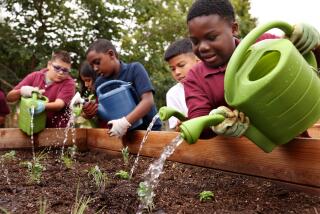Schools Offer an Outside Chance to Study Nature : Education: The Las Virgenes district sends students to camp to learn about such subjects as endangered species and tide-pool creatures.
- Share via
If it’s spring, it must be outdoor education time for Las Virgenes School District fifth-graders.
There they are, hopping all over Cottontail Ranch in Calabasas, delighted to be out of the classroom and sharing an experience they say they will never forget.
Outdoor education is to the school district what Magic Johnson is to the Lakers and “Masterpiece Theater” is to television--the jewel in the crown.
It began in 1970, when a teacher said to himself, “We ought to get these kids out of the building and let them learn about science in an outdoor setting.”
David Roen--who teaches at Yerba Buena Elementary School--went to district administrators with plans for a weeklong camping expedition during which all of the school’s fifth-graders would have the opportunity to see the things they were reading about in class.
“There was some precedent for such a thing, because the Los Angeles Unified School District offers a similar program, but on a very limited scale,” Roen said.
Still, it was a daring proposal and something of an administrative nightmare with all of its logistic, financial, staffing and legal ramifications.
Roen, nevertheless, got the go-ahead, and off he went with about 80 10-year-olds, their teachers and a staff.
“That first year, I and my fellow team teacher, Carolyn Kist, did the budget, found the camp, made up the curriculum, arranged for staff, arranged for the parent meetings, arranged the transportation, planned the hikes, led the hikes, served the food and washed the dishes,” he said, shaking his head.
He now has a full staff, and for good reason. After the much-heralded success of his school’s outing, Roen was asked to arrange a similar program for each of the district’s other elementary schools. By the next spring, Roen found himself in charge of a program in which each of the seven elementary schools sent their fifth-graders to camp for a week with their teachers and counselors, one school after other. Parents pay $140 per child, but financial aid is available.
For the past six years, the camp has been located at Cottontail, a Malibu Canyon site that is used as a conference center and summer camp at other times.
“We have always used camping facilities in the Santa Monica Mountains, which makes it so much better,” Roen said. “We are looking at, and learning to preserve, our own land and wildlife. We see the Santa Monica Mountains every day, and the program helps the kids become aware of what’s involved with protecting this area that is their heritage. “
The camp curriculum has evolved over the years, and is now much more ecologically structured. The classes, taught by the youngsters’ own teachers, as well as outside experts, include ornithology, endangered species, insects, tide-pool creatures, the stars, compass reading, sand-painting, rocks and ecology.
One of the experts, oceanographer Lorraine Sadler, leaves her home on Catalina Island at dawn, goes to a San Pedro lab to pick up the tide-pool animals she will show the children that day and drives to the camp with the critters in appropriate containers, Roen said. At the end of the lesson, she retraces her steps.
The outdoor classrooms include the camp site, Malibu Creek State Park, Malibu Lagoon and the Malibu ranger station.
There are also short and long hikes, backpacking hikes and a lot of tired bodies every night in the eight-kids-and-a-counselor cabins. Girls stay in the cabins on the south side of the pool, and the boys are on the north.
The counselors are all high school students who have gone through an intensive interviewing process and come highly recommended by their teachers. They miss a week of school that they must make up on their own. They are not paid for counseling.
Still, there is fierce competition for the jobs, Roen said, especially from youngsters who remember when they went to a camp.
Andrea Giardina, for example.
Giardina, a senior at Agoura High School, was chosen to be a counselor during the first session when fifth-graders from Sumac School were in camp.
“Unless you have had the experience of outdoor ed, you really can’t understand how excited the kids get about it. You first start hearing about it when you are in kindergarten or before that from your brothers and sisters,” she said. “After you have gone to camp, you start thinking about being a counselor. It’s a really big deal. A big honor.”
It also helps you grow up.
“I’m a teacher’s aide at Sumac, and I baby-sit every day after school, so I’m used to being around kids,” Giardina said. “But when you have responsibility for eight or 10 children 24 hours a day, you start to get an idea of what it’s like to be a parent.”
According to Willow School teachers Sandy Pope, who has been coming to camp with her students for 10 years, and Annie Haas, who is in her 20th year, outdoor education is wonderful for the kids, but separation anxiety is sometimes hard on parents.
“We have parents who are terrified to let the kids go away for a week,” Pope said. “They will ask if they can come and observe, or if they can come and help.”
Both requests are denied.
“The program was set up, in part, to help the youngsters build confidence in themselves and their own choices,” said Barbara DeCamp, Roen’s co-director. “The fifth-graders will be going from elementary school to middle school at the end of this semester, and it’s a big transition. We want outdoor ed to boost their self-confidence.”
Roen said he is always awed by the growth he sees in youngsters during camp, and Haas said there is one child she will never forget.
“This little boy was wracked with medical problems and so hyper-allergic that he had had to spend the first three years of his life in an oxygen tent,” Haas said.
“His parents at first refused to let him come at all, and then said he could come during the day only,” she said. “But he was having so much fun he refused to go home. His mother went for his clothes and his medical equipment, which included all kinds of medicine and inhalers and a portable oxygen tent.”
Haas said she watched him gain strength and confidence during his five-day stay. “One day, I saw him by the pool, jumping in with the rest of the guys, and the look on his face was pure joy,” Haas said.
This year, as always, children show up at camp with all kinds of medicines that the counselors have to monitor. Some even show up on crutches.
Monica Dougherty from Willow Elementary School was one of those students on crutches. But nothing was going to keep her from this event.
“I just sprained my ankle at a track meet,” she said. “But I had to come to camp because I’ve been looking forward to it for so long.”
Meri Dunn, seated next to her in the lodge-like dining hall during the lunch break, held up her bandage-covered hand. “I broke my finger playing softball, but here I am too,” she said.
On Friday afternoons, when all the Sumac youngsters are packed and ready to go, there is a low buzz of conversation as it started to sink in that this was their last meal together in this setting, that outdoor education is over for them.
“They are tired and get a little depressed at having to leave,” co-director DeCamp said, looking over the group. “But once they see their parents and home, they’ll be fine.”
The counselors are even more subdued once the kids are gone and they board their bus to their high schools, carrying a week’s worth of dirty laundry and a fistful of goodby letters from their young charges.
“On the way home on the bus, all the counselors read their letters from the kids, and by the time we were through everyone was crying,” Giardina said. “Even the guys.”
The counselors were so emotionally charged that it was hard for them to come down. “We left the camp Friday afternoon and by Friday night we were all together again at the house of one of the counselors,” Giardina said. “At the beginning of the week, we didn’t really know each other well. But by the end of the week, we felt close. We just sat around that night and talked about the experience and how it had changed us,” she said.
Giardina said that in some ways, she is sad. “I feel like a part of my life is over--first wanting to go to outdoor ed, then getting to be a counselor. Now that’s all through.”
For Roen, who started it all, there are regrets as well.
When the last group of youngsters from Roen’s home school of Yerba Buena leaves on May 24, it will be the end of his long and successful run as outdoor education director.
“I’ve been doing this for more than 20 years, and that’s long enough,” he said. “But the program will go on, of course.”
More to Read
Sign up for Essential California
The most important California stories and recommendations in your inbox every morning.
You may occasionally receive promotional content from the Los Angeles Times.










